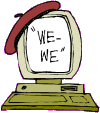Jan's Computer Basics:
Computer to Computer: Software
You can't just hook up your computer to a network or a modem and start sending and receiving data. The computer needs instructions on how to do this. You need some kind of communications software. Since there are a number of different communications tasks, there are different kinds of programs that manage those tasks.
Dialing
 Dialing software tells the computer how to place a call on the phone line connected to it. It also displays
messages about the progress of the call or lack thereof. A list of phone numbers for frequently called, or frequently forgotten, numbers is an important feature.
Dialing software tells the computer how to place a call on the phone line connected to it. It also displays
messages about the progress of the call or lack thereof. A list of phone numbers for frequently called, or frequently forgotten, numbers is an important feature.
These capabilities are often included in other software packages.
File Transfer
One of the most common uses of computer to computer communications is to transfer files from one to the other.
|
Downloading means to transfer a file to your computer from elsewhere.
|
Uploading means to transfer a file from your computer to another.
|
Programs that manage this process include many file management features. You need to be able to see what files are available, their sizes, and the folders you can put the transferred file in. You may want to rename the file or create a new folder for your new file.
Such a program will also handle the process of connecting to the other computer. Many of the names of these programs include the letters FTP, which stands for File Transfer Protocol. (Yes, another kind of protocol. And there are more!!)
Terminal Emulation
Programs running on a network often make an assumption about what kind of keyboard is being used. Keyboards for terminals used on networks often have assigned special functions to certain keys. They may even have keys that don't exist on standard keyboards. In order to work with the network programs, you need a program that will disguise your keyboard and make the network think that you are one of them! You must emulate, that is mimic, the keyboard that is expected.
A terminal emulation program will make:
 |
look like |
 |
to the network. |
Data Encryption

When sending data over a communications channel, there is always the possibility that someone will see your data that you didn't mean to. If your data is of a sensitive nature, like your credit card number, or if it is secret, like the formula for Coca-Cola, you'd probably like to keep strangers from reading it.
A data encryption program encodes your data, just like spies do. So to read it, a person would need the right decoding program and the right password or file to give that program so it would know what to do exactly.


